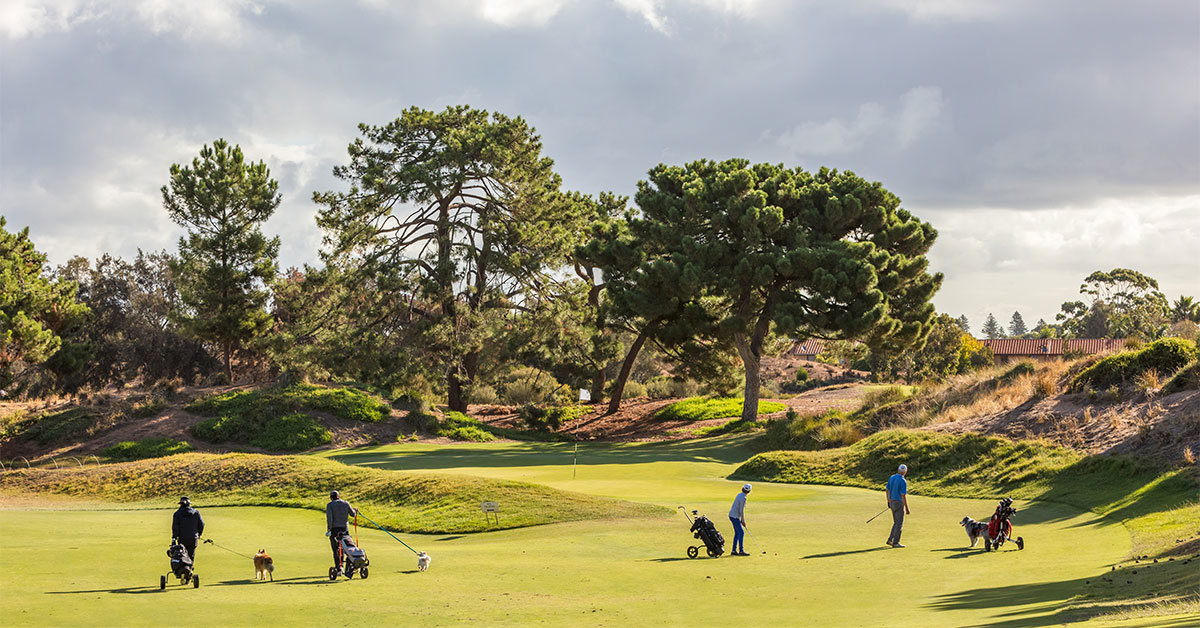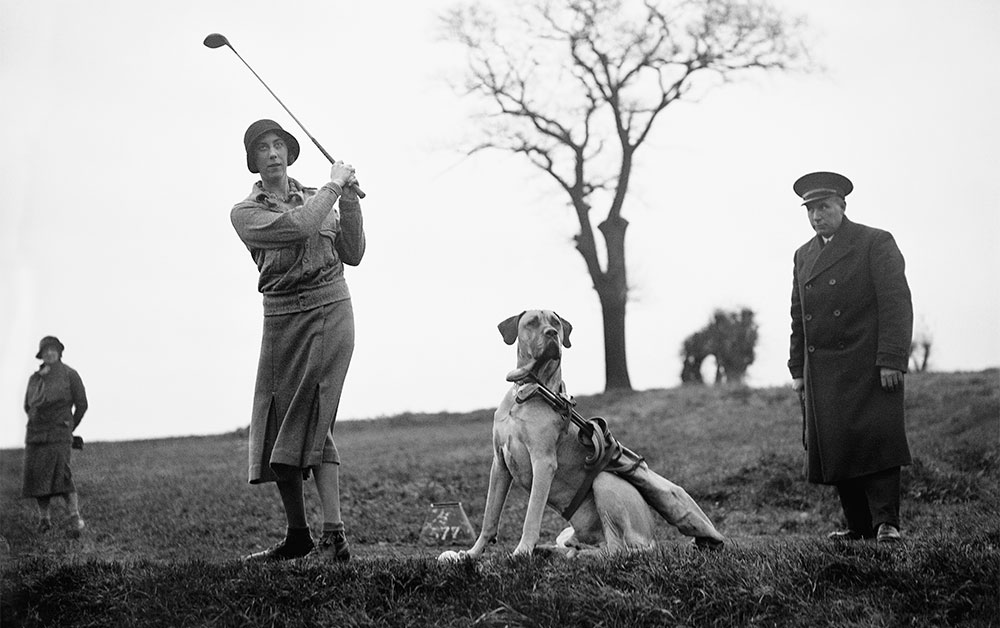Bringing man’s best friend to the course is the most fun you’ll ever have.
So you have a dog. You know you’re a real bastard each time you leave for a four-hour round after a 10-minute walk (or even no walk), but hey, that’s golf. With most starters you’d have better luck wearing Borat’s bathing suit and playing out of your friend’s bag than getting permission to bring your pooch along. The barking, chasing of balls, a steamy pile directly in the line of a birdie putt – it’s these fears and more that ultimately lead to your getting handcuffed on the second green as you watch your best friend get it NYPD style from animal control.
But it doesn’t have to be this way. If golf embraced dogs, think of the problems this would solve. No more rushing home with guilt to let out Rex. Young children would be kept entertained through periodic downturns in golf interest. Ankle-lickings after wayward shots would improve player temperament and, in turn, scrambling performance. And if handled conscientiously, dogs could be the perfect solution, rather than a cause, for slow play.
Most courses allow only one dog: the superintendent’s. (The life of a super’s dog – all day running alongside or even riding in Master’s cart, chasing geese and diving into water hazards – is discussed in canine circles like winning the lottery or marrying into Augusta National membership.) As crazy as a pack of dogs wrestling at the bag drop might sound, canines have an intimate history with shepherds, the game’s inventors. And dogs are still regularly encountered on the links of the United Kingdom.
“Many overseas visitors are surprised by the number of dogs they see on the courses and around the clubhouse,” says John Churchill, the club historian and a member of prestigious Sunningdale Golf Club in England. The best golf dogs heel when players are hitting, never walk on greens or in bunkers, and even retrieve lost balls. Dogs-in-training are tethered to a golf bag, a buggy or handed to a caddie. A few kilometres down the road at the Berkshire Golf Club, members may bring their dogs, but visitors must ask permission from the club secretary. “In this way, badly behaved dogs can be discouraged, and there is no need for a blanket ban that takes away the delight a dog provides,” writes finegolf.co.uk.
In the UK, dogs are more likely to be allowed at old links courses with lots of common walking ground than at newer, inland operations. And not to delve into a subject as thorny as the British class system, but golf dogs tend to have a stronger tradition at clubs established by land-owning families for whom fox hunting was an important pastime. Golf was just something else to do in clever tweed when not busy training champions bred from royal bloodlines.

Finally finding their bark Down Under
Aussies tend to treat dogs like family members, which might be holding back the cause of dog golf in a nation built by and for mutts.
Some 38 percent of Australian households own a dog. That’s an estimated 4.8 million pet pooches; or 20 dogs for every 100 people. It’s said that nearly half of these have slept in the same bed as their owner.
Why it has taken so long is not important right now but the big ruff, sorry, revelation in golf is that dogs are starting to land tee-times in select pockets of Australia. Royal Adelaide, a club filled to the brim with tradition and history, is em-barking – sorry, again! – on a new plan to keep members happy. The club recently welcomed 50 golfers and 29 dogs to play the course – the tee-times selling out four weeks prior to the event, giving general manager Andrew Gay a waiting list and plenty to think about.
“The inspiration behind our dog day was initially driven by a past captain who had a desire to combine walking his dog with playing golf, as he had seen players do in Scotland,” Gay tells Australian Golf Digest. “The concept also had appeal as an opportunity for the club to offer an activity, that wasn’t focused around competitive golf, and therefore may appeal to those less actively involved members within the club. On the day we had a very diverse range of members along with family and friends enjoying the course with their dogs.”

Gay said one of the unexpected benefits of hosting dog days had been the social-media attention and the interest from golf magazines world-wide.
“Finding strategies to engage with our irregular playing members is important and ‘Dog Day’ gave a certain section of the membership an ideal opportunity to use the facilities,” he says. “One of the key drivers to belonging to a golf club is fun and enjoyment, and this event ticks both boxes. Not only did members love the idea of playing a few holes of golf with their dogs, they also loved the relaxed social experience before and after the round. The mini-shotgun start allowed our dog loving members a chance to mingle with like-minded dog and golf lovers. The relaxed social atmosphere afterwards was fantastic and offered an entirely different experience to other events at the club. The pressure is already on to schedule the next Dog Day.”
“One of the key drivers to belonging to a golf club is fun and enjoyment, and this event ticks both boxes.’ – Andrew Gay, Royal Adelaide Golf Club
After hearing about the puppy privileges on offer at Royal Adelaide, Newcastle Golf Club general manager Christian Gillott wanted to test the waters with his members.
“I really loved the concept. I had a chat to some of their team and they didn’t encounter any major issues, so we pulled the trigger,” Gillott says. “Being the GM and the owner of a very well behaved golden retriever, the decision was a bit easier to make.”
Gillott said the event fit perfectly in the club’s 2023 Strategic Plan by “promoting a family-friendly culture”.
“We held our event on Father’s Day to try to encourage families to participate,” Gillott says. “We’re trying to break down barriers that golf clubs are old, traditional places with lots of rules and regulations. We just wanted to try something a little more fun and interesting. We had an extremely positive response from the membership that participated. An event like this provided them with a different perspective on their golf club, and we think it added further value to their membership. There’s no doubt it assists with member satisfaction and, in turn, retention.”
Gillott’s advice for other clubs considering a doggy day was to set the guidelines early – and clearly – so all dog owners are aware of what the expectations are. “Allow some time before tee-off for some of the dogs to socialise and get to know one another and make sure they’ve all been worn out on the golf course,” says Gillott. “It makes for a nice, quiet post-event barbecue to take place.”

Lessons we can learn from abroad
Golf courses are not enclosed, air-conditioned spaces in constant battle for hygiene. Belgrade Lakes Golf Club in Maine, the northernmost state in the New England region of the north-eastern United States, whose $US125 green fee indicates conditioning that’s anything but dog track, got into the business of allowing dogs because of temperature. “We get a lot of families on road-trip holidays, and people were leaving dogs in their cars while they played,” says managing partner Kyle Evans. To rectify the cruelty, Evans built a complimentary kennel with shade and fresh water by the cart shed. As word of the dog-friendly course spread, the kennel started to fill up. That’s when Evans decided, “Heck, just let ’em out on the course.”
“They make it pretty public that they encourage it, and when we first heard about the policy, we were thrilled,” says Jeff Baron, whose wife, kids and a 10-kilogram mix-breed named Rosie enjoyed many rounds as a family. Rosie (R.I.P.) loved riding on the cart seat almost as much as a cut-up hotdog at the turn. The key lesson for the Barons was turning the cart off before each shot. “Rosie accidentally hopped on the accelerator pedal a few times, which was almost disaster,” Dad says.
In the recreationally progressive San Francisco Bay Area, two Marin County facilities, Indian Valley Golf Club and San Geronimo Golf Course, allow dogs. Any staff member can bring a dog to work, even if it’s just to hang around the golf shop and get fat.
“Yes, we’re a dog-friendly course,” says Mike Beaver, an employee at Indian Valley. “But if your dog causes a problem, we’ll change our policy. Your dog must either be leashed or well-behaved. Pick up crap and rake paw prints in bunkers. It’s pretty easy. Everyone knows a tired dog is a good dog, and we get a lot of good dogs here.” And it’s not like the place is overrun. A big week sees “maybe 20 dog rounds”.
Seaside Golf Course in Oregon, an aptly named nine-holer with affordable green fees, has never had an issue with Canis lupus familiaris, or domestic dog. Regular Bob Best has a dachshund named Scout that sometimes walks, sometimes rides. “Sometimes Scout gets in the way, but everyone is pretty cognitive of keeping an eye on him,” Best says. His mate has a Husky that wears a harness and actually pulls a buggy. Never has a looper projected a more perfectly eager disposition.
“My big dog is scared of the sound of the club hitting the ball, so I don’t bring him, just the dachshund,” Best says. “We tried, but each time after a few holes I had to take him back.”
“Dogs are very environmentally oriented,” Klein says. “Inside, outside, in a public park among other dogs and strangers, in each situation they respond differently. People who bring a dog to the golf course should consider the first two to three rounds strictly a training experience.” Don’t worry what you shoot.
Interactions, indeed, are everything with dog golf. Even Bill Loeffler, the 1986 US Mid-Amateur champion and a Colorado Golf Hall of Famer, knew to proceed slowly at Castle Pines Golf Club, where he and his wife, Sandy, are members. “I started by taking our dogs to the practice range late in the evening,” Loeffler says. They’ve since gained permission to go on the course. “I’m psycho about making sure my dogs are well-behaved,” Loeffler adds, “because as soon as something happens, that’s it.”

The Loefflers own an executive course, The Links at Highlands Ranch, which for more than 10 years has hosted The Dog Gone Invitational. The strokeplay format adds penalty strokes to owners’ golf scores for their dogs’ transgressions, like whining or unauthorised swimming. One unaware resident phoned the pro golf when she saw 30 dogs running down the hole by her deck. Says Sandy Loeffler: “It was so much fun. Each year we get more people calling, wanting to get into the tournament, saying, ‘This has been my dream.’”
As much as the Loefflers love dogs, the couple is reluctant to have a fully open policy. “What makes it hard is there are bad dog owners. You never know who’s going to walk in the door,” Sandy says. “If we started allowing dogs, we’d probably have to make it a designated evening during the week and make people sign a waiver, like with a cart. The fact is, dogs can’t cause as much trouble as how some people drive or push carts.”
“As long as people are cognisant of the fact golfers have the right of way, there’s no reason joggers, walkers, dogs and children can’t all enjoy the same land,” says Doug Stein, a plus-1-handicapper at Lookout Mountain Golf Club in North Carolina. Stein likes the notion of returning the game to its Scottish roots, where courses are treated like town greens. As for his black-haired rescue, Steiny, the Labrador mix needs to learn not to chase wildlife. Until then, Steiny’s golf will be limited to late afternoons on a leash.
“One day he’ll play in the club championship,” Stein says.
A long walk through nature with frequent stops – could there be a more ideal activity for man and beast? The timing has never been better for those who want to promote dog golf as a cause. More than ever, golf courses are willing to relax rules that will meaningfully make the game attractive to a larger audience. Dogs were present at the start of golf’s history. Whether they’ll be part of the future is up to their owners.
5 Questions With A Dog
1. Thanks for speaking with us. How’s your reception at the golf course so far?
Are you kidding? I’m like a rock star here. Kids and women throw themselves at me. I’ve walked with the head pro. The geese know what’s up.
2. How’s your owner’s game?
Not bad. Sometimes we don’t lose any balls.
3. Many golfers who don’t want dogs say you’re going to pee and poop everywhere. Is that true?
First, dogs are no worse than most guys, who let it all out in one go, so it’s more damaging. As for No.2, I’m incredibly selective about location. I get that fairways are sacred ground, but don’t expect me to trample out between weeds and scrub when the rough’s right there. Just bring a bag.
4. If you could convey one thought to your master?
Why do we play in the rain when we have a fireplace and food at home?
5. I can tell you feel strongly about that. Anything else?
I can smell your blood pressure rising. Relax. Though it is fun seeing you get all worked up over a game.




